Building Innovation: Who’s the 2024 Exceptional Woman in Building?

The 2020 National Earthquake Hazards Reduction Program (NEHRP) Recommended Seismic Provisions: Design Examples, Training Materials, and Design Flow Chart (FEMA P-2192) have been developed by the NIBS Building Seismic Safety Council for the Federal Emergency Management Agency (FEMA) to illustrate and explain some of the new changes in the 2020 NEHRP Provisions, ASCE/SEI 7-22, and the material design standards referenced.
The three-volume resource document was primarily developed for design practitioners; however, college students learning about earthquake engineering and engineers and architects studying for their licensing exam or designing in regions of moderate and high seismicity will find the document’s explanation of earthquake engineering, the 2020 NEHRP Provisions, and ASCE/SEI 7-22 seismic provisions helpful.
NIBS hosted the first of a series of BSSC NEHRP webinars around the Design Examples on January 20, 2022. The webinar received nearly 400 registrants.
Mai (Mike) Tong, senior physical scientist with the FEMA National Earthquake Hazards Reduction Program, explained the webinar series will help share interpretation, thoughts, considerations, and supporting research for the changes in the 2020 NEHRP Provisions and ASCE/SEI 7-22. He said the series also will provide the opportunity to meet with experts who led the development of the major seismic code changes in the 2015-2020 cycle of the NEHRP Provisions.
How the FEMA NEHRP Helps to Increase Earthquake Resilience
FEMA’s mission is to reduce suffering of disaster survivors, and studies and post-disaster investigations show that preparedness, protection, and mitigation are the most effective ways to save lives, reduce property damage, and minimize disaster impacts.
A recent FEMA report, Building Codes Save: A Nationwide Study of Loss Prevention, shows that in selected high seismic regions buildings conforming to modern building codes save $60 million in annualized losses from earthquake hazards.
The FEMA NEHRP strives to improve seismic resistant national standards and model buildings with new research results and lessons learned information. It also aims to encourage at-risk communities to adopt up-to-date model building codes.
Understanding the Role of the NEHRP Provisions in Seismic Code Development
Bret Lizundia, principal with Rutherford + Chekene in San Francisco and a member of the BSSC Provisions Update Committee, discussed the webinar’s learning objectives, including understanding the role of the Provisions in seismic code development, gaining an awareness of seminal past seismic code changes, and learning what’s new to the 2020 NEHRP Provisions and to ASCE/SEI 7-22. He also broke down what is contained in the Design Examples and how the document can be used.
“[The NEHRP Provisions] are the starting point in the U.S. seismic standards development process,” Lizundia said.
The intent of the Provisions is to provide reasonable assurance of seismic performance that will:
Highlights of Major Changes to the 2020 NEHRP Provisions and ASCE/SEI 7-22

There were many changes to the 2020 NEHRP Provisions. These include, but are not limited to:
The next webinar in the BSSC NEHRP series – Fundamentals of Earthquake Engineering – takes place on February 10, 2022. The webinar also will be broadcast live on the NIBS Facebook page.